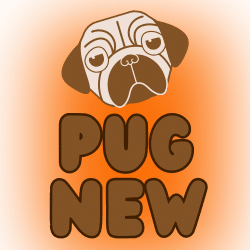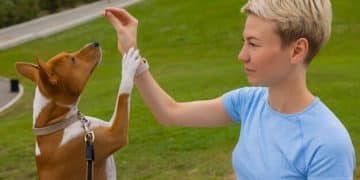Decoding Dog Body Language: 5 Signs Your Dog Is Talking To You
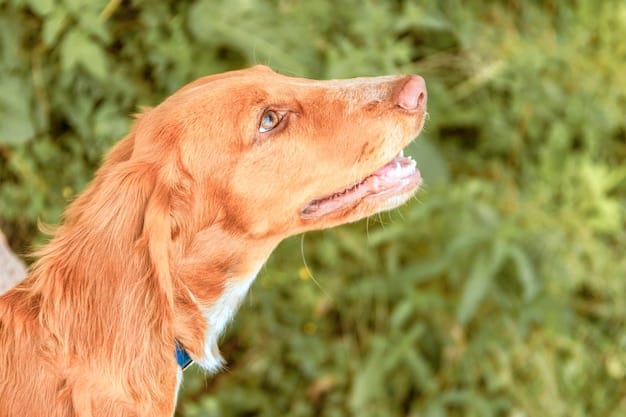
Anúncios
Decoding dog body language involves understanding subtle cues, such as tail wags, ear positions, and eye contact, to interpret your dog’s emotions and intentions effectively.
Understanding your furry friend goes beyond the basic commands. Decoding dog body language: 5 subtle signs your dog is trying to tell you something can unlock a deeper connection, helping you respond to their needs and strengthening your bond.
Anúncios
Understanding the Basics of Dog Communication
Dogs communicate in many ways, and understanding these signals will lead to better understanding and will improve their general well-being. Their posture, facial expressions, and vocalizations all paint a picture of how they’re feeling.
The Importance of Observing Your Dog
Pay close attention to your dog’s typical behaviors. This will help you pick up on subtle changes indicating stress, anxiety, or excitement. By taking time to observe your dog in diverse locations, you will be more ready to read their body language.
Anúncios
Environmental Factors Affecting Behavior
Consider the environment. Is there a loud noise? An unfamiliar person? These factors can influence your dog’s behavior and make it easier to understand why they’re acting a certain way.
- Tail Position: A wagging tail isn’t always a happy tail. The height and speed of the wag can indicate different emotions.
- Ear Placement: Ears forward mean they’re alert, while ears pinned back suggest fear or submission.
- Body Posture: A relaxed dog will have a loose, wiggly body. A tense dog may be stiff and still.
Understanding the basics of dog communication allows you to comprehend their intentions and emotions. These signals, including position of the tail and the placement of the ears, are important in understanding your dog’s behavior.
Sign #1: The Whale Eye (or Half-Moon Eye)
One of the more subtle signs your dog is trying to give you is the “whale eye.” This is when you can see the whites of their eyes, usually indicating discomfort or anxiety.
What the Whale Eye Signifies
Whale eye, or half-moon eye, often indicates that a dog is feeling uneasy, threatened, or possessive. It’s important to identify the cause of the distress and remove the dog from this environment.
How to Respond to the Whale Eye
If you notice your dog showing whale eye, immediately assess the situation. Give them space, speak calmly, and remove any perceived threat. By noticing these warning signs, you can prevent them from getting worse and respond to any possible difficulties.
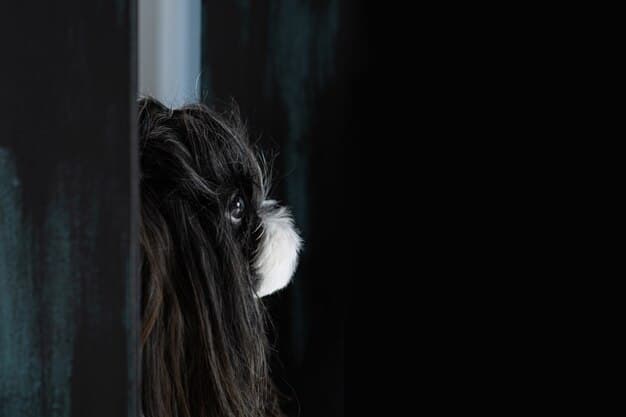
Recognizing the whale eye is crucial for preventing potential reactivity. Observing this signs enables you to take quick and thoughtful steps to make sure that your dog feel secure and safe.
Sign #2: Lip Licking and Yawning (Out of Context)
While lip licking and yawning are normal behaviors, they can also be signs of stress when they occur outside of mealtime or sleepiness.
Why Dogs Lick Their Lips When Stressed
Lip licking is often a displacement behavior, meaning it’s a way for dogs to release tension. It signals internal conflict or discomfort.
The Meaning Behind Stress-Related Yawning
Yawning, when not related to tiredness, is another calming signal. Dogs use it to self-soothe and to communicate their unease to others around them.
When not due to sleepiness or meal times, lip licking and yawning are indications of anxiety. It is critical to observe these behaviors in conjunction with other body language cues to fully comprehend what your dog is trying to say.
Sign #3: The “Play Bow” Invitation
A play bow is an adorable gesture, but it’s crucial to understand its implications. It’s usually an invitation to play, but context matters.
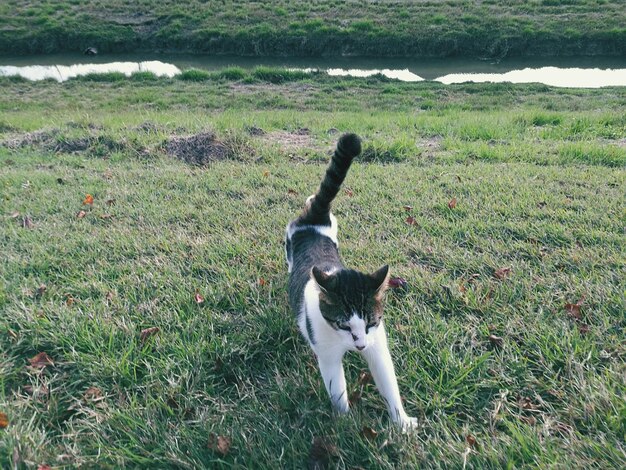
Interpreting the Play Bow in Different Situations
A play bow often means your dog is feeling playful and wants to interact. However, it can also be used to diffuse tension in social situations.
The Importance of Reciprocal Body Language
If your dog offers a play bow, respond in a way that matches their energy. You can mirror the bow, engage in gentle play, or simply acknowledge their invitation with a smile and a kind word.
- Examine the context: Look at whether your dog is engaging in playful interactions with other dogs or people.
- Pay close attention to posture: A relaxed, wiggly body indicates fun, while a tense body may indicate anxiety.
- Watch the tail: Usually a wide-range, wagging tail illustrates excitement and invitation.
The play bow, while joyful, should be observed in terms of environment and additional body language. The combination of these variables provide a comprehensive image of your dog’s mindset at that moment.
Sign #4: Avoidance Behaviors
Sometimes what your dog *doesn’t* do speaks volumes. Avoidance behaviors, such as turning away, walking away, or hiding, are clear indicators of discomfort.
Recognizing Avoidance Tactics
Dogs use avoidance to distance themselves from things they find threatening or uncomfortable. They’re trying to create space and reduce stress.
How to Create a Safe Space for Your Dog
Respect your dog’s need for space. If they’re avoiding something, don’t force them to interact. Instead, identify the stressor and work on desensitization and counter-conditioning in a safe, controlled environment.
Avoidance tactics, such as turning away, are clear indicators of discomfort. By recognizing and respecting these limits, you can maintain a safe and trusting connection with your dog.
Sign #5: Changes in Appetite or Sleep Patterns
Subtle changes in your dog’s eating or sleeping habits can be a sign of underlying stress, anxiety, or even medical issues. It’s important to address these concerns promptly.
Linking Appetite Changes to Emotional States
Stress and anxiety can lead to a decrease or increase in appetite. Monitor your dog’s food intake and consult a vet if you notice significant deviations.
Deciphering Sleep Pattern Disruptions
Changes in sleep patterns, whether it’s restlessness or excessive sleeping, can also indicate underlying issues. Provide a comfortable and secure sleeping environment to promote restful sleep.
Observe the changes in your dog’s regular feeding and sleeping habits. These changes are signs of deeper emotional or physical problems. Pay close attention to these signs, and get help from your veterinarian to ensure your pet’s well-being.
| Key Sign | Brief Description |
|---|---|
| 👁️ Whale Eye | Indicates discomfort or anxiety when whites of eyes are visible. |
| 👅 Lip Licking/Yawning | Shows displacement behavior due to stress or internal conflict. |
| 🤸 Play Bow | Signals invitation to play, but context is crucial. |
| 🚶 Avoidance Behaviors | Indicates discomfort; involves turning/walking away. |
FAQ: Decoding Dog Body Language
▼
Whale eye, also known as half-moon eye, occurs when you can see the whites of a dog’s eyes. Usually shows discomfort, anxiety, or feeling threatened in their current environment.
▼
Frequent lip licking, especially when not related to food, can be a sign of stress or anxiety. It’s a displacement behavior, indicating the dog is trying to cope with internal conflict.
▼
A play bow typically signals an invitation to play. Dogs lower their front legs while keeping their rear end up, showing they’re in a playful mood and want to interact.
▼
Avoidance behaviors include actions like turning away, walking away, or hiding. These actions show that a dog has become uneasy and trying to create more space for themselves.
▼
Changes in appetite, such as decreased or increased eating, can indicate emotional states like stress or anxiety. Monitoring your dog’s appetite can provide great understanding into their mental health.
Conclusion
By learning decoding dog body language: 5 subtle signs your dog is trying to tell you something, you may enhance your relationship with your canine friend. By carefully watching these indications and adjusting your conduct accordingly, you can build a stronger bond and create a happier, more harmonious environment for both of you.
